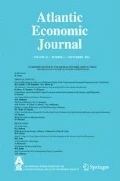Abstract
We develop a bargaining model to assess how workers and employers might allocate wages inter-temporally in order to cope with risk. We then apply this model to 106 long-term contracts for major league baseball players’ services. Most of these agreements not only smooth employee compensation over time but suggest greater relative risk aversion for teams than players. Compared to the wages they might pay to retain these players on a succession of one-year contracts, teams often pay a premium on longer-term agreements to protect against market volatility and potential inability to replace a key player on the open market.


Similar content being viewed by others
Notes
For some apprentices this period is only two seasons. These “super-twos” have two to three years of service and are among the top 22% of such players with respect to playing time.
These proportions are slightly higher than those found for the period 1979–2001 by Burger and Walters (2005), perhaps reflecting a trend for arbitrators to award higher salaries in recent years. We are grateful to an anonymous referee for noting this possibility.
Since all dollar values are expressed in real, inflation-adjusted terms, we use a real interest rate to discount all future values to a present value as of the time the CE is signed. Real rates on some instruments were negative for part of the sample period, but we conservatively follow Girola (2005) and assume a 3% real discount rate in these calculations. Somewhat higher or lower rates did not significantly affect our results.
In the context of Figure 1, if there is a certain probability that a player’s future \( \widehat{MRP} \) might shift up significantly relative to our assumed level and the negotiated salary SCE, then our estimated area (A+ B – C) will be inaccurate. We are grateful to an anonymous referee for noting this possibility. We find, however, that for a representative set of contracts, a permanent productivity increase of 100%, arriving with 50% probability, is necessary to have a marginal effect on the likelihood of offering a CE. Previous work by Krautmann (2017) indicates that the average annual variance in a key component of WAR for a sample of 281 hitters over 5 years is only 8% and the average size of the range of values is just 24% of the typical value. There seems little chance, therefore, that our sample of CE signees is made up disproportionately of players that would give rise to these concerns.
References
Baseball Prospectus (2016a). Sortable statistics. Retrieved, 2016, from http://www.baseballprospectus.com/sortable/.
Baseball Prospectus (2016b). Cot’s baseball contracts. Retrieved, 2016, from http://www.baseballprospectus.com/compensation/cots/.
Burger, J. D., & Walters, S. J. K. (2003). Market size, pay, and performance: a general model and application to Major League Baseball. Journal of Sports Economics, 4(2), 108–125.
Burger, J. D., & Walters, S. J. K. (2005). Arbitrator bias and self-interest: lessons from the baseball labor market. Journal of Labor Research, 26(2), 267–280.
Burger, J. D., & Walters, S. J. K. (2008). The existence and persistence of a winner’s curse: new evidence from the (baseball) field. Southern Economic Journal, 75(1), 232–245.
Girola, J.A. (2005). The long-term real interest rate for social security. U.S. Dept. of the Treasury, research paper no. 2005-02 (march 30).
Kahn, L. M. (1993). Free agency, long-term contracts and compensation in Major League Baseball: estimates from panel data. Review of Economics and Statistics, 75(1), 157–164.
Krautmann, A. C. (1999). What's wrong with Scully-estimates of a player's marginal revenue product. Economic Inquiry, 37(2), 369–381.
Krautmann, A. C. (2017). Risk-averse team owners and players’ salaries in Major League Baseball. Journal of Sports Economics, 18(1), 19–33.
Krautmann, A. C., von Allmen, P., & Berri, D. (2009). The underpayment of restricted players in North American sports leagues. International Journal of Sport Finance, 4, 75–93.
Maxcy, J. (2004). Motivating long-term employment contracts: risk management in Major League Baseball. Managerial and Decision Economics, 25(2), 109–120.
MLB Trade Rumors (2016). Extension tracker. Retrieved, 2016, from http://www.mlbtraderumors.com/extensiontracker.
Rosen, S. (1985). Implicit contracts: a survey. Journal of Economic Literature, 23(3), 1144–1175.
Sandomir, R. (2015). The safety net that Ruth built. The New York Times (June 2): B15.
Scully, G. (1974). Pay and performance in major league baseball. American Economic Review, 64(6), 915–930.
Solow, J. L., & Krautmann, A. C. (2011). A Nash bargaining model of the salaries of elite free agents. Journal of Sports Economics, 12(3), 309–316.
Spotrac (2016). FA database. Retrieved, 2016, from http://www.spotrac.com/mlb/free-agents/.
U.S. Census Bureau (2016). Annual estimates of the resident population. Retrieved, 2016, from https://factfinder.census.gov/faces/tableservices/jsf/pages/productview.xhtml?src=bkmk.
Wachter, M. L., & Wright, R. D. (1990). The economics of internal labor markets. Industrial Relations, 29(2), 240–262.
Author information
Authors and Affiliations
Corresponding author
Rights and permissions
About this article
Cite this article
Walters, S.J.K., von Allmen, P. & Krautmann, A. Risk Aversion and Wages: Evidence from the Baseball Labor Market. Atl Econ J 45, 385–397 (2017). https://doi.org/10.1007/s11293-017-9545-7
Published:
Issue Date:
DOI: https://doi.org/10.1007/s11293-017-9545-7




